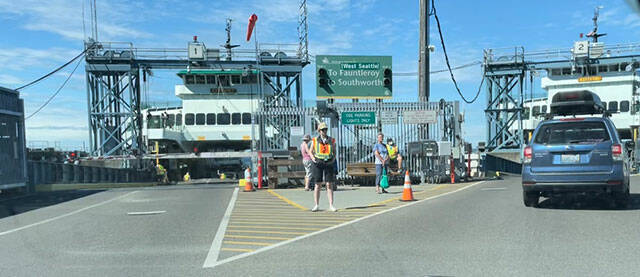Since mid-October 2021, islanders have dealt with a modified schedule since Washington State Ferries (WSF) announced that the triangle route would move from its normal three-boat schedule to a two-boat schedule for an indefinite period of time.
With Vashon’s summer season in full swing, WSF has yet to restore the three-boat schedule to the Fauntleroy-Vashon-Southworth route.
“It’s not where we want to be as an agency at all,” said WSF Public Information Officer Ian Sterling in an email to The Beachcomber, citing a worldwide shortage of mariners as one of the reasons for schedule inconsistencies.
The agency’s COVID-19 Service Restoration Plan (see bit.ly/3IV1S8j) details a multi-stage process that includes goals such as maintaining the reliability of service, ensuring service restoration can be maintained, prioritizing routes based on ridership needs and facilitating customer communications.
While WSF operates a total of eight routes, the Fauntleroy-Vashon-Southworth routes is ranked fifth in WSF’s route prioritization list.
Sterling added that WSF has now moved from seasonal hiring to continuous hiring, and is training new hires as quickly as possible.
In addition, the agency is now in the process of restoring service on its routes, with “near pre-pandemic service” on the Anacortes/San Juans Islands, Seattle/Bainbridge and Mukilteo/Clinton routes, said Sterling.
Sterling stressed that WSF does not currently have a firm date for adding boats back to routes that have a reduced schedule.
“The moment we have adequate staff, demand, and vessels available, look for restoration to continue,” said Sterling. “It will likely be months before we see pre-pandemic service on all routes.”
The absence of the typical three-boat schedule has put a strain on Vashon’s businesses.
Cheryl Lubbert, president of Vashon Chamber of Commerce’s Board of Directors and co-owner of Nashi Orchards, described how the ongoing two-boat schedule makes Vashon less appealing to visitors, as long lines at the ferry terminals deter visitors, she said.
Lubbert also recounted a recent video she watched of travel vloggers visiting Vashon Island.
The vloggers, Lubbert said, stressed how much time they had spent waiting to take ferries back and forth to Vashon and how they had little time to visit island businesses during their day trip – a concern Lubbert also has for island visitors unfamiliar with WSF and who may feel rushed during their time on Vashon in order to catch a boat back home.
Her own business, Nashi Orchards, has faced late or canceled reservations, which sets back the business’ day, said Lubbert.
If there’s a particularly slow day, for instance, she said, her staff will check to see if ferries are delayed or canceled.
Lubbert said she feels a “sense of futility with WSF” with the ongoing schedule reduction, as ferries not only impact her business’ customer base, but also impact her employees who commute from West Seattle to Vashon. Infrequent ferries also make items more expensive, according to Lubbert.
“It has a cascading domino effect,” she said.
The reduced schedule also impacts operations at Vashon Island Fire and Rescue (VIFR).
According to Interim Fire Chief Matthew Vinci, VIFR historically is “moderately busier” throughout the summer season, as the district experiences higher emergency medical services (EMS) volumes from April to August.
As WSF moved the Triangle route to the two-boat schedule, sailings were less frequent, had less direct routes and had larger gaps in overnight sailings, said Vinci.
“All three of these realities make it challenging scenarios to provide timely emergency medical care,” he said. “However, these scenarios are managed very well by our shift captains, who work diligently to secure the most effective transport to either Tacoma or Seattle hospitals.”
There have also been occasions where VIFR has two aid cars off the island at emergency rooms, waiting on the dock to return to Vashon, or requiring a crew to be called back for a third EMS call.
“Our emergency services are time-critical, highly technical, and require safe, adequate staffing to have the best outcome possible,” he added.
If ferries are not available, said Vinci, the primary route of transport for critical or medically unstable patients is by air ambulance.
In the situation a helicopter isn’t available or cannot fly, VIFR can work with WSF to divert its nearest boat to transport a patient to the mainland, he added.


